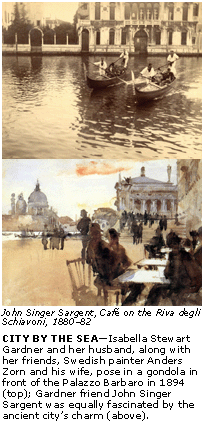
Some celebrations are so good you just don't want them to end. And so it has become the case with the extended Centennial Celebration of the 1903 opening of the Isabella Stewart Gardner Museum in Boston's Fenway neighborhood. As a bookend to last summer's The Making of the Museum exhibit, which chronicled the actual construction of the building, its ever-blooming central courtyard and the installation of its art treasures, the Gardner Museum now presents Gondola Days: Isabella Stewart Gardner and the Palazzo Barbaro Circle, an exhibit revealing the inspiration behind the beloved institution, which runs until the end of summer.
The Palazzo Barbaro of the exhibit's title was a remarkably well-preserved, 15th-century palace in Venice that was frequented by a fascinating mix of artists, writers and intellectuals around the turn of the 20th century. Owned by Boston expatriates Daniel and Ariana Curtis, the Barbaro served as an Italian retreat for Boston socialite Isabella Stewart Gardner and her husband Jack off-and-on from 1884 to 1906. A globetrotting couple, the Gardners nevertheless found themselves back at the Barbaro quite frequently, often staying for months at a time to drink in the history and culture of that ancient city.
Of course, as the exhibit demonstrates, they were not the only ones drawn to that grand palazzo. Some of the most prominent creative figures of the day also spent time there, including Henry James, John Singer Sargent, James McNeill Whistler, Claude Monet and Robert Browning. It's no coincidence that this mingling of minds, as well as the Barbaro's classic architecture, was duplicated at Mrs. Gardner's own "Fenway Court," her name for her museum in its early days.
 That
Venetian-style edifice, housing the art collection of Mrs.
Gardner, has remained exactly the way she left it since her death
in 1924-which is what makes this exhibition so unprecedented.
This is the first time in the museum's history that its fourth
floor, previously Mrs. Gardner's living quarters and, in recent
years, offices for the museum's staff, has been opened up to the
public.
That
Venetian-style edifice, housing the art collection of Mrs.
Gardner, has remained exactly the way she left it since her death
in 1924-which is what makes this exhibition so unprecedented.
This is the first time in the museum's history that its fourth
floor, previously Mrs. Gardner's living quarters and, in recent
years, offices for the museum's staff, has been opened up to the
public.
A wonderfully unique and intimate space has been prepared by museum curator Alan Chong and his colleagues. Helping to put things in historical perspective are the many one-of-a-kind fixtures Mrs. Gardner imported from her former Beacon Street residence-including an intricately carved mantle, Tiffany andirons and a rare, art nouveau chandelier-that visitors can now enjoy for the first time.
The exhibit's main highlights, however, are the many paintings, prints and drawings on display that have been gathered from a host of prominent museums in this country and Europe, as well as from the Gardner Museum's own permanent collection. Sargent, a good friend of Mrs. Gardner who once had a studio at Fenway Court, is particularly well-represented. Although ironically he and Mrs. Gardner never stayed at the Barbaro at the same time, Sargent had his own deep fascination with Venice, reveling in the canals, plazas and gondolas that are an integral part of that city's charm. Many works by the lesser-known Swedish artist Anders Zorn, a close friend of the Gardners whom they hosted at the Barbaro, can also be found, including a sparkling portrait of Mrs. Gardner from 1894 painted in Venice that has been relocated from the lower galleries. Now overlooking the museum's courtyard, the painting has been given new context as Mrs. Gardner's shining face beams at the blossoming nasturtium in the glowing splendor beyond the window.
Archival material from the Gardner Museum's own holdings also enlivens the exhibit, giving viewers a time-capsule glimpse into what it was like in those heady days along Venice's Grand Canal. Included are Mrs. Gardner's voluminous guest books, in which many sketches and notations were made by visiting artists and writers, as well as photographs of Mrs. Gardner, her husband, her friends and the local denizens and architecture.
This exhibition is an opportunity not to be missed. After all, it very well could be another hundred years before visitors can gather in this space again. Regardless of the public's invasion of her former living quarters, however, we're sure Mrs. Gardner would approve.
Due to limited space, timed tickets
must be purchased at an additional cost to regular museum
admission.

back to homepage